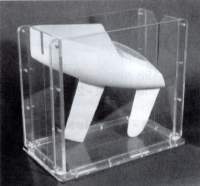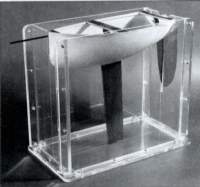
RCGroups Sailboat Forum

Yahoo Footy Group

Sail Footy UK

by Niel Goodrich
 Brujo placed diagonally and on an angle in the measurement box. Photo by Ruby Levesque. |
The Footy Class is new territory. It was conceived as a builder's class. Small boats governed by simple rules that would encourage newcomers and old hands, young and the young at heart, male and female to get involved with building model yachts. Footys don't seem daunting to the passerby; they are often called cute, but don't be fooled by their inviting appearance. There has been an awful lot of serious effort and ingenuity bubbling in the background.
As evidenced by the dozen boats in the photo spread following this article, representing designers from five countries, there is no archetype for this class as yet. Many of these designers have different observations of Footy performance characteristics and rationales for their design approaches. The designers generously provided the photographs and basic statistical information that accompanies them, so that others could derive starting points for their own Footy projects.
As an international class all measurements are metric, so for those who can't visualize metric measurements, some math may be required. To convert millimeters to inches multiply the metric number by 0.0394. To convert a decimal fraction of an inch to 32nds, multiply the fraction by 32. To convert gram weights to ounces divide the grams by 28.35.
Generally speaking, the Footys being developed in the UK and the commonwealth countries are pushing the minimum weights to lower totals. Many of these weights result from using lightweight electronics and Lithium batteries, combined with ultra-light building techniques, lower volume hulls, and McCormack rigs. It remains to be seen if these boats can stand up to the wear and tear of fleet racing. Here in the US, the Footy fleet average is a little over a pound in all-up weight. So far, most US builders are leaning toward a more conservatively built boat. Several of the boats represented in the photo spread are commercially available, and these too tend to be on the heavier end of the spectrum.
Construction methods run the gamut from hard-chine hulls made from foam and balsa panels to molded ones in composites or fiberglass. The focus of some designers is on ease of building, while others make intricate molds for every component. But building light is the universal imperative because every gram shaved from the hull will benefit either the displacement-to-ballast ratio or the overall weight.
Most of the designers represented here use fore-and-aft placement in the box. The box features slots in the front (for a bowsprit) and the back (for a stern mounted rudder) that encourage this sort of placement. The weight of a Footy displacing the equivalent volume of water over a 12-inch waterline length accounts for the stout appearance of many of the boats. Three of the designers have used unconven- tional placement in the box to gain waterline length and smooth out the hull shape. But tak- ing advantage of the box's interior dimensions this way comes with its own tradeoffs.
 Bantam 2 placed conventionally in the measurement box. Photo by Ruby Levesque. |
Moonshadow is placed diagonally in the box (more or less from corner to corner). This also gains waterline length but requires a narrow hull to fit properly. Moonshadow does not have to carry an unusually shaped rig and doesn't sacrifice keel depth. She is also the lightest boat represented, in both hull and overall weight figures.
Brujo combines these concepts, using both angled and diagonal placement. The raised deck/cutwater brings the rig up to the top edge of the box so that the rig swings clear. Brujo will gain waterline length but sacrifice keel depth and a low center of effort. Brujo is a high volume boat with her displacement about average.
Obviously there are many creative ways of fitting a boat into the measurement box. Of course, by the time this issue is in your hands, much of this information will be old news, and the Footy class, propelled by the energies of many innovative people, will have taken off in new directions. This vitality fuels the rapid growth of this new and exciting class.
I would like to acknowledge the people who helped make this presentation happen. Herman Estevez worked with the photographs and layout, and Ruby Levesque typeset the layout. Thank you both. And, of course, my thanks go out to the designers who participated in this article for their generous gift of information.
Additional notes:
The abbreviations d, b, and wlb, stand for deck, beam, and waterline beam, respectively.The deadline for this article found the Bantam 2 and Brujo still under construction, and still missing bulbs (they are closer to completion but not quite there yet). I build Footys using this method to determine how much keel depth a boat can potentially have and then subtract the bulb dimension (which is dependent on the weight of the hull and rig all up) from that depth. These photos were only to illustrate different placements in the box. Eventually the hulls with appendages and bulb attached will have to fit within the confines of the measurement box.